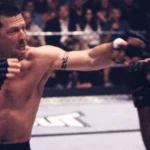Hey there, fight fans! Get ready to meet Tim Sylvia, the legendary giant of MMA. We’re about to uncover the secrets behind this towering titan, from his early days to his epic battles in the cage. Get ready to explore the facts that made him a true icon in combat sports.
Facts About Tim Sylvia:
Ever heard of a gentle giant? That’s Tim Sylvia in a nutshell. Standing tall at 6’8″, Sylvia wasn’t just about size – he was a powerhouse in the ring. Imagine being his opponent, feeling dwarfed by his presence, and then – BAM! His reach and knockout power were legendary, making him a force to be reckoned with in the octagon.
Sylvia’s MMA journey began in 2001, and he climbed the ranks with impressive speed. He became a two-time UFC Heavyweight Champion, holding the title for an incredible 1,072 days – longer than anyone else in the division’s history. Talk about leaving a mark!
But Sylvia wasn’t content with conquering just the UFC. He took his talents to other renowned MMA organizations like Affliction, ONE Championship, and Strikeforce, proving his adaptability and hunger for competition. He even tried his hand at professional boxing, defeating former heavyweight champion Ray Mercer!
While his size was certainly intimidating, Sylvia wasn’t just about brute strength. He was a skilled and well-rounded fighter, even earning a black belt in Brazilian Jiu-Jitsu. This meant he could knock you out with a single punch or submit you with a clever grappling technique – talk about versatility!
Outside the ring, Sylvia was known for his charitable work, particularly his support for veterans and those less fortunate. Though he retired from professional MMA in 2013, his legacy as a legendary heavyweight fighter continues to inspire aspiring fighters and fans alike.
How many times did Tim Sylvia win the UFC title?
Tim Sylvia, the giant of MMA, was a beast in the ring, and he captured the UFC Heavyweight Championship title not once, but twice, securing his place as a legend in the sport.
His first title win was an epic clash with Ricco Rodriguez at UFC 41, where he dominated, announcing his arrival as a force to be reckoned with. However, this victory was tainted by a positive test for a banned substance, leading to his title loss. It was a setback, but one that adds a layer of complexity to Sylvia’s story.
Undeterred, Sylvia fought his way back to a title shot at UFC 54, facing Andrei Arlovski in a fight for the ages. Sylvia reclaimed the title in a triumphant return, showcasing his dedication and resilience.
Unfortunately, his second reign as champ was cut short when he faced Frank Mir. During the fight, Sylvia suffered a brutal broken arm, forcing him to tap out and relinquish the title once again.
Despite the ups and downs, Sylvia retired from MMA in 2015 with an impressive record of 31 wins and 10 losses. His two championship belts and the record-breaking 1,072 days as champion cemented his place in MMA history. His sheer size, raw power, and never-give-up attitude continue to inspire fighters, proving that Tim Sylvia’s impact on the sport extends far beyond wins and losses.
Where does Tim Sylvia live now?
After a whirlwind career in the octagon, Tim Sylvia has traded the roar of the crowd for the tranquility of Keosauqua, Iowa. This small town in the heartland of America is where the former UFC Heavyweight Champion now calls home.
Don’t be fooled into thinking Sylvia is taking it easy, though. He’s still a force to be reckoned with, just in a different arena. These days, you’re more likely to find him stalking through the woods with a bow in hand than throwing punches in a cage.
Sylvia has always been an avid outdoorsman, and he’s turned his passion into a way of life as an active member of the “Hit Squad Outdoors” program. His social media feeds are filled with thrilling hunting expeditions and impressive catches, a testament to his outdoorsmanship.
It’s a far cry from his days battling it out with the best heavyweights on the planet. Sylvia’s career was a rollercoaster of victories and defeats, filled with both triumphant highs and crushing lows. He was known for his imposing size and power, a formidable opponent for anyone who dared to step into the cage.
Sylvia’s journey included legendary battles with some of the biggest names in MMA history, including Frank Mir, Andrei Arlovski, and Randy Couture. He wore the UFC Heavyweight Championship belt twice, securing his place as a true giant of the sport.
Even though he officially retired from MMA in 2013, Sylvia’s legacy as a fighter continues to inspire a new generation of athletes. He remains a popular figure in the MMA community, respected for his achievements and his willingness to engage with fans. And while he may have left the world of professional fighting behind, his competitive spirit is clearly alive and well in his outdoor pursuits.
Life after fighting has been kind to Sylvia. He’s found contentment in the simplicity of his Iowa home, surrounded by nature and loved ones. He frequently shares glimpses of his life on social media, showcasing his hunting trophies, his beloved dogs, and his collection of classic cars.
Tim Sylvia’s story reminds us that there’s life after the spotlight fades, even for those who have reached the pinnacle of their profession. It’s about finding new passions, embracing new challenges, and discovering fulfillment in unexpected places.
Why did Tim Sylvia retire?
Tim Sylvia, the former UFC Heavyweight Champion, decided to hang up his gloves in 2015. It was an unexpected turn of events, driven by a confluence of factors.
Money Matters:
Despite his epic wins, Sylvia felt undervalued by the UFC. He believed his experience and track record warranted a larger paycheck. This dissatisfaction with his compensation played a significant role in his decision to retire.
The Fedor Factor:
At the time, Fedor Emelianenko was considered the heavyweight to beat. Sylvia was eager to test himself against the legend, but the UFC’s exclusive contracts hindered those aspirations. He felt restricted from pursuing career-defining fights outside the organization.
Contractual Constraints:
The UFC’s contractual restrictions limited Sylvia’s freedom to explore other opportunities. He desired more autonomy, seeking the ability to participate in fights that piqued his interest and potentially boost his income.
Life Beyond Fighting:
The demanding nature of professional fighting took its toll on Sylvia. He yearned for a change of pace – to explore other passions, engage in charitable work, and, most importantly, spend more time with his family.
A Convergence of Factors:
Tim Sylvia’s retirement resulted from a combination of factors. He was a fighter caught between the demands of the sport and the desires of his heart. It highlights the pressures faced by athletes who must balance their passion for competition with their personal lives.
While his UFC days are over, Sylvia’s legacy as a Heavyweight champ endures, inspiring a new generation of fighters. His story reminds us that even in the world of combat sports, there’s more to life than just the fight.
Did Frank Mir break Tim Sylvia’s arm?
Frank Mir’s submission skills are legendary, and his fight against Tim Sylvia at UFC 48 stands as a testament to his prowess on the ground. The fight, with the heavyweight title on the line, ended in a way no one could have foreseen.
Mir, always hunting for a submission, expertly transitioned into an armbar on Sylvia’s right arm. Sylvia, known for his toughness, attempted to fight through the pain. However, Mir’s leverage proved too much, and in a moment that sent chills down the spines of viewers, Sylvia’s arm snapped.
Despite the graphic injury, Sylvia, displaying incredible heart, refused to tap. Referee Herb Dean, recognizing the severity of the situation, immediately stepped in and stopped the fight. The image of Sylvia’s arm hanging at an unnatural angle is seared into the memories of many MMA fans.
The impact of that night extended far beyond the Octagon. Sylvia, a two-time UFC heavyweight champion, faced a long and arduous road to recovery. The injury required surgery and extensive rehabilitation, significantly impacting his career.
Years later, Sylvia revealed that the screws inserted during the initial surgery had loosened, leading to a serious infection. He sought financial assistance from the UFC for the additional medical expenses, but his request was denied. This situation shed light on the challenges faced by many fighters after their fighting days are over, particularly when grappling with the long-term consequences of injuries.
Who is the tallest UFC fighter ever?
While Tim Sylvia, at 6’8″, was an imposing figure in the UFC, the title of tallest fighter goes to Stefan Struve, who stands at an astounding 6’11.8″. Imagine stepping into the Octagon against someone who could practically touch the ceiling!
Sylvia’s height and reach made him a formidable opponent. It’s no surprise that he secured two UFC Heavyweight Championship titles and earned his place in UFC history. However, being a giant in MMA is not a guaranteed path to victory.
Sylvia used his height and weight to control fights, but his long limbs could also be a liability, making him vulnerable to takedowns. His career demonstrates that while height can be a significant advantage, it’s not the only ingredient for success in the UFC.
Interestingly, although Stefan Struve is the tallest UFC fighter ever, he never won a championship belt. This highlights the fact that while height can be an asset, it doesn’t guarantee victory in a sport as dynamic and multifaceted as MMA.
Key Takeaways:
- Stefan Struve, at 6’11.8″, holds the record for the tallest UFC fighter ever.
- Height, while advantageous, can also present challenges in MMA, particularly in wrestling and grappling.
- The Heavyweight division, with its unlimited weight limit, naturally attracts the tallest fighters.
- No fighter with exceptional height has ever won a UFC championship, demonstrating that other factors, like skill and strategy, are equally important.
What is Tim Means’ record in UFC?
Tim Means is a force to be reckoned with in the UFC, and his record reflects his skill and power. With 33 wins in his professional fighting career, he’s proven himself against some of the best in the world.
As of today, Means’ UFC record stands at 33 wins, 16 losses, and 1 draw, a testament to his experience and resilience in a sport known for its fierce competition.
What makes Means’ record particularly impressive is the manner in which he secures those wins. He is known as a knockout artist, with 20 of his victories coming by way of knockout. He’s a fighter who knows how to turn the lights out on his opponents.
Means’ fighting style is characterized by his speed and power. He has an impressive four first-round finishes, demonstrating his ability to end fights decisively and early. His 49% striking accuracy and the 1452 significant strikes he’s landed over his career highlight his effectiveness as a striker.
However, Means is more than just a puncher. He’s overcome significant challenges outside the Octagon, battling addiction and serving time in prison. His ability to turn his life around and achieve success in the UFC is a testament to his resilience and determination.
Here’s a breakdown of Tim Means’ UFC record:
- Total Fights: 50 (approximately)
- Wins: 33
- Losses: 16
- Draws: 1
- Knockouts: 20
- First-Round Finishes: 4
These numbers are constantly evolving as Tim Means continues to fight. He remains a captivating figure in the sport, and his future bouts promise to be just as exciting as his past performances.
For more fascinating insights into the world of combat sports, check out these articles:
Ever heard of the legendary Japanese mixed martial artist, Shinya Aoki? No? Here’s a chance to know facts about Shinya Aoki and his journey to becoming a champion.
Meet Carole King, one of the most successful singer-songwriters of the 20th century. Her legacy continues today, and many of her classics have become standards. Click facts about Carole King to know her incredible life story.















